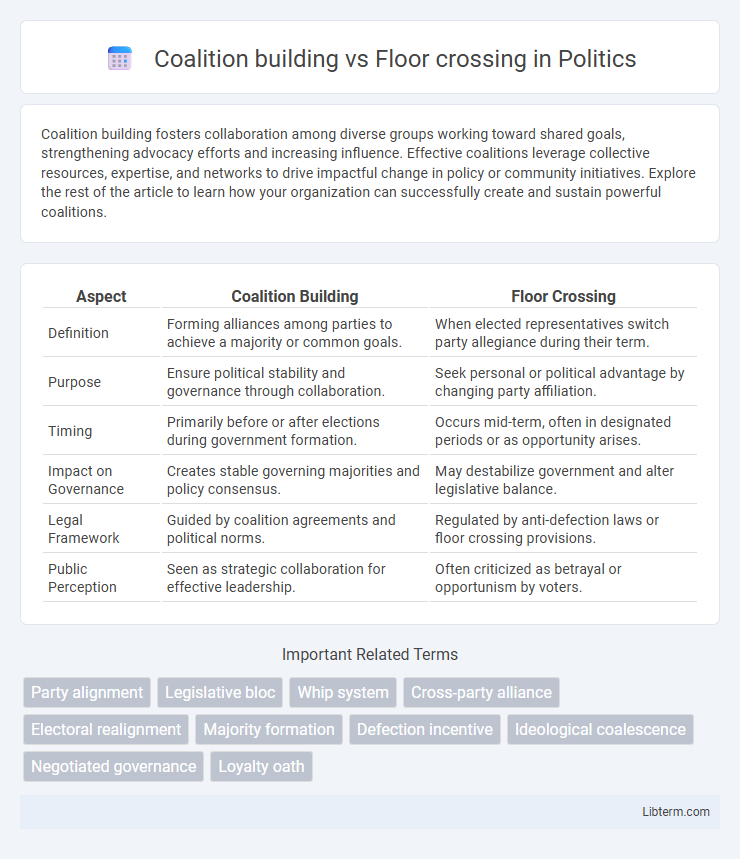Coalition building fosters collaboration among diverse groups working toward shared goals, strengthening advocacy efforts and increasing influence. Effective coalitions leverage collective resources, expertise, and networks to drive impactful change in policy or community initiatives. Explore the rest of the article to learn how your organization can successfully create and sustain powerful coalitions.
Table of Comparison
| Aspect | Coalition Building | Floor Crossing |
|---|---|---|
| Definition | Forming alliances among parties to achieve a majority or common goals. | When elected representatives switch party allegiance during their term. |
| Purpose | Ensure political stability and governance through collaboration. | Seek personal or political advantage by changing party affiliation. |
| Timing | Primarily before or after elections during government formation. | Occurs mid-term, often in designated periods or as opportunity arises. |
| Impact on Governance | Creates stable governing majorities and policy consensus. | May destabilize government and alter legislative balance. |
| Legal Framework | Guided by coalition agreements and political norms. | Regulated by anti-defection laws or floor crossing provisions. |
| Public Perception | Seen as strategic collaboration for effective leadership. | Often criticized as betrayal or opportunism by voters. |
Introduction to Coalition Building and Floor Crossing
Coalition building involves forming alliances between multiple political parties or groups to achieve a common goal, often aimed at securing a majority in a legislative body. Floor crossing refers to the act of elected representatives changing their party allegiance while retaining their seats, impacting the balance of power within the legislature. Understanding these mechanisms is crucial for analyzing political stability, party dynamics, and legislative decision-making processes.
Defining Coalition Building in Politics
Coalition building in politics refers to the strategic alliance of multiple parties or groups to form a majority or enhance influence within a legislative body. It involves negotiation, compromise, and shared goals to establish a stable governing body or pass legislation. Unlike floor crossing, which is the act of elected officials switching party allegiance, coalition building is a collaborative process aimed at achieving collective objectives.
Understanding Floor Crossing: What It Means
Floor crossing refers to the practice where elected representatives switch allegiance from one political party to another during their term, impacting the balance of power within legislative bodies. This act differs from coalition building, which involves parties collaborating to form a majority without members physically changing party affiliation. Understanding floor crossing requires analyzing its effects on party dynamics, voter trust, and legislative stability.
Historical Context: Coalition Building vs Floor Crossing
Coalition building historically emerged as a strategic alliance between multiple political parties to form a majority government, particularly evident in parliamentary systems like post-World War II Europe where fragmented legislatures were common. Floor crossing, on the other hand, originated as an individual legislator's act of switching party allegiance within a legislative term, gaining prominence in countries such as India and South Africa during periods of political realignment. Both practices reflect mechanisms to navigate political instability, with coalition building emphasizing collective negotiation and floor crossing representing personal political maneuvering.
Key Motivations Behind Coalition Building
Key motivations behind coalition building include achieving majority control in legislative bodies, pooling resources for enhanced policy influence, and fostering political stability through collaboration among parties with aligned interests. Coalitions enable smaller parties to gain representation and negotiate power-sharing agreements, thereby maximizing their legislative impact. Floor crossing, in contrast, often reflects individual strategic repositioning rather than collective strategic alliance formation.
Drivers and Consequences of Floor Crossing
Floor crossing occurs when elected representatives switch party allegiance, driven by ideological shifts, political opportunity, or dissatisfaction with party policies. This behavior often leads to changes in legislative majorities, destabilizing coalition governments and triggering shifts in policy direction. As a consequence, floor crossing can undermine voter trust and prompt calls for stricter regulations to maintain political stability and accountability.
Legal and Ethical Implications
Coalition building involves strategic alliances between political parties to form a government, guided by legal frameworks that regulate party cooperation and mandates, whereas floor crossing allows individual legislators to switch parties, raising legal challenges regarding the mandate's legitimacy. Ethically, coalition building is often seen as a collaborative approach to governance promoting stability, while floor crossing can undermine voter trust by contradicting electoral commitments and destabilizing representative accountability. Both practices demand robust legal oversight to balance political flexibility with maintaining democratic integrity and public confidence.
Impact on Political Stability
Coalition building promotes political stability by fostering collaboration among multiple parties, ensuring a more balanced representation and reducing abrupt shifts in governance. Floor crossing, however, often triggers political instability due to sudden party changes by legislators, which can undermine party cohesion and disrupt established majorities. Empirical studies indicate that countries with frequent floor crossing experience increased legislative volatility and weakened public trust in political institutions.
Case Studies: Coalition Building and Floor Crossing in Practice
Case studies reveal that coalition building involves strategic alliances formed to achieve common political goals, often enhancing stability through negotiated agreements, as seen in the 2010 UK coalition government. Floor crossing, exemplified by South Africa's post-apartheid era, enables legislators to switch parties without losing seats, impacting party dynamics and legislative majorities. Analysis of these practices highlights their distinct effects on governance, party cohesion, and electoral accountability in different political systems.
Future Trends and Recommendations
Coalition building is expected to evolve through increased digital collaboration platforms, enabling more transparent and dynamic partnerships among political entities, whereas floor crossing will face stricter regulations to curb opportunistic party shifting. Future trends indicate that coalition strategies will prioritize policy alignment and voter engagement analytics to enhance stability, while legislative frameworks aim to balance party loyalty with individual representatives' autonomy. Recommendations include investing in data-driven decision-making tools for coalition negotiations and implementing clear legal boundaries to ensure floor crossing does not undermine democratic accountability or electoral mandates.
Coalition building Infographic

 libterm.com
libterm.com